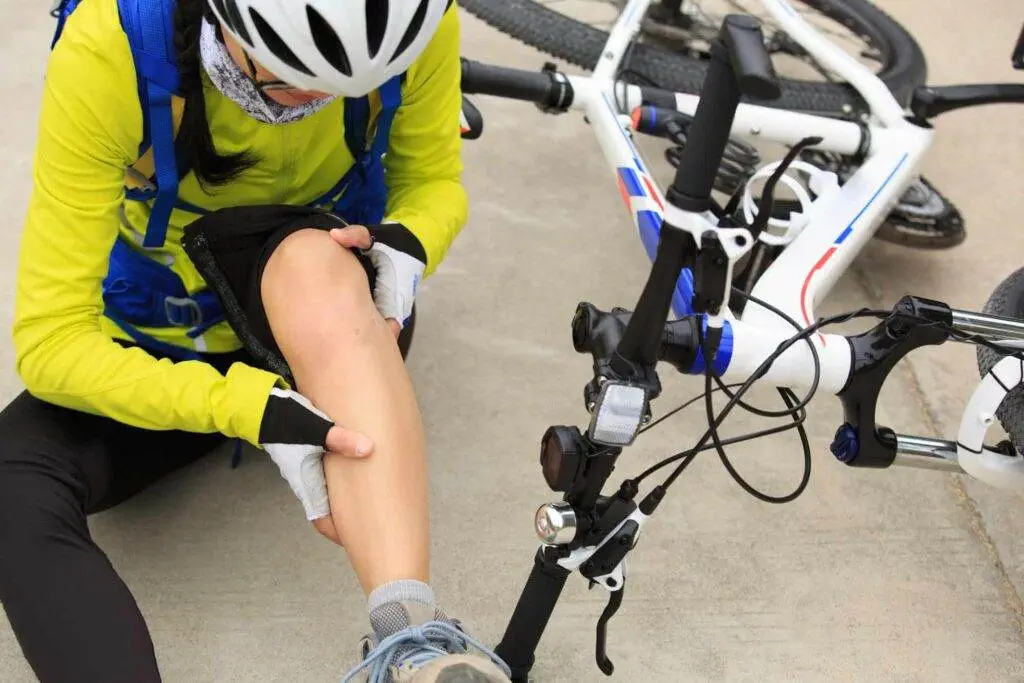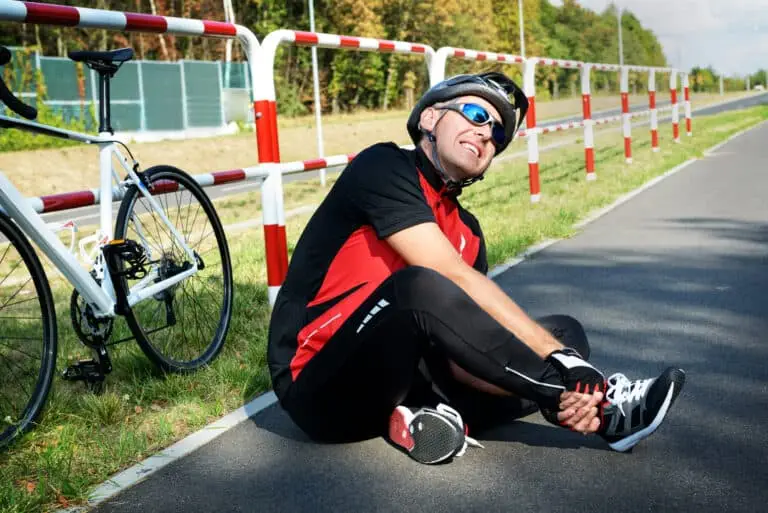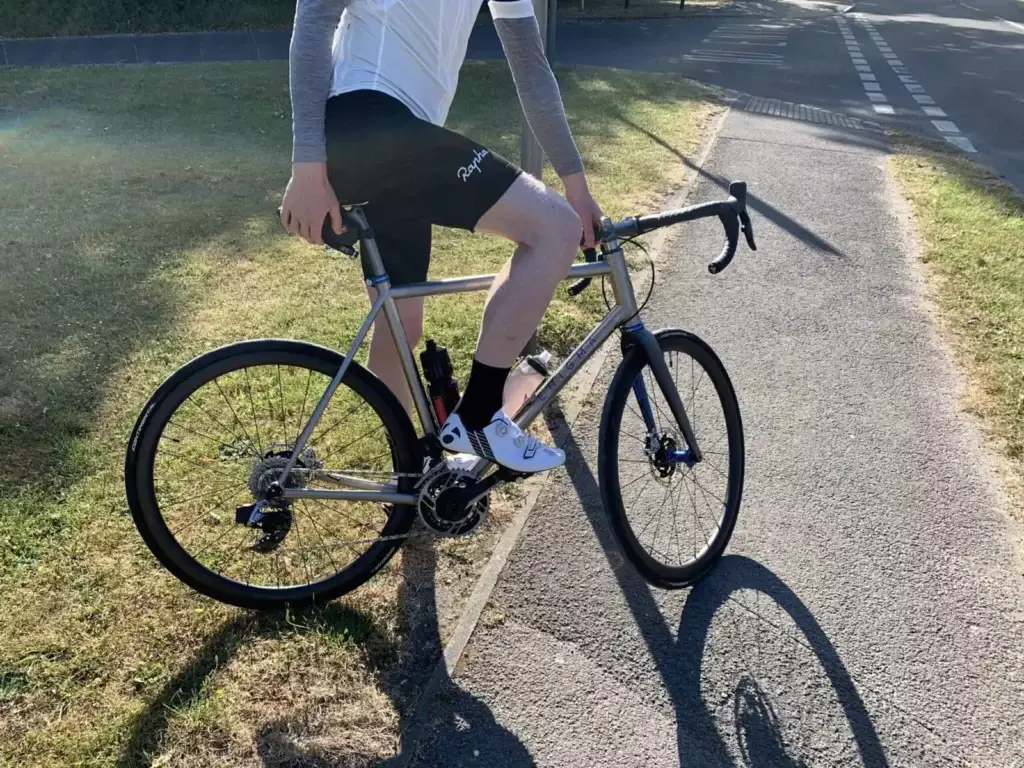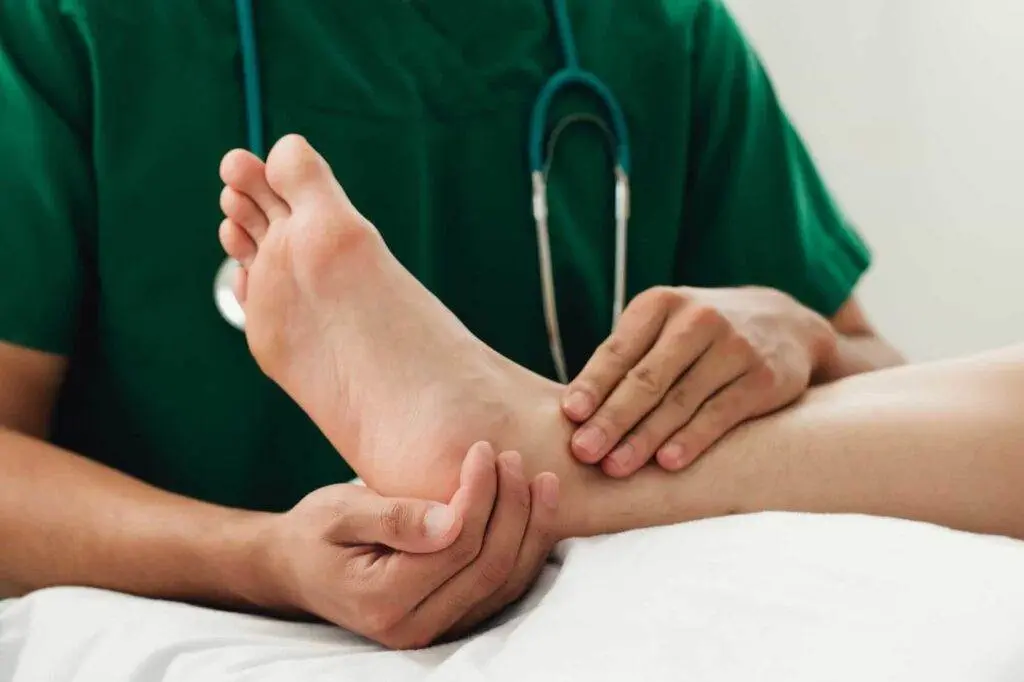Sustaining an injury is not only painful, but it can also interrupt a training schedule or exercise routine that you enjoy.
Determining whether or not you should continue exercising is essential.
This is because you run the risk of worsening your injury, leading to longer recovery times on the sidelines.
A sprained ankle can be a very painful and debilitating injury.
However, because cycling is considered a low-impact form of exercise, many people think it will be fine to hop straight on a bike.
This article will explore whether or not cycling with ankle sprains is advisable.
Key Takeaways: Can You Bike with a Sprained Ankle?
- An ankle sprain is when ankle ligaments are torn or stretched.
- Sprained ankles will typically take up to six weeks to fully heal.
- Cycling is often recommended as part of the recovery process from sprained ankles.
- Stationary bikes are best for sprained ankle recovery.
- You shouldn’t cycle until you can put weight on your foot without feeling pain.

What is a Sprained Ankle?
Ankle sprains are typically caused by twisting or turning the ankle. This can stretch or tear your ligaments.
Your ankle ligaments are essential for stabilizing the ankle joint. Ligaments are cord or band-like tissue that connects bones together, especially around joints.
Damaged ankle ligaments can compromise the stability of the ankle. This puts the person at greater risk of damage if they continue to use it as normal.
Not all sprains will result in the same damage. There are three grades of ankle sprain, which include:
Grade 1
A grade 1 ankle sprain is the mildest sprain. This is when a ligament is overstretched. It can result in pain when you put weight on the affected foot.
A grade 1 sprain may result in swelling or bruising and recovery times will typically take a few weeks.
Grade 2
A grade 2 ankle sprain is considered to be a moderate sprain. This is typically a result of an overstretched ligament that has a partial tear.
This will be more painful than grade 1 ankle sprains and result in swelling and bruising.
The estimated recovery time for grade 2 ankle sprains will usually be between 4 and 6 weeks.
Grade 3
Grade 3 ankle sprains are considered to be severe sprains. This is when a ligament is completely torn and results in intense pain, swelling, and bruising.
Torn ligaments mean it will be very difficult to put any kind of weight on the foot for some time.
The estimated recovery time for this type of ankle injury is measured in months rather than weeks. On average, an ankle joint with a grade 3 sprain can take between 3 and 6 months to recover.

Why Biking With a Sprained Ankle is Not Recommended
Cycling with a sprained ankle is not recommended during the early stages of recovery. This is because you run the risk of further injury until the ankle can support your body weight without pain.
If you try to cycle too early, you will feel pain after the exercise and the injured ankle may start to swell up again.
Using a stationary bike during the recovery process is recommended. This is because you will get the physical benefits of cycling while doing it in a controlled environment.
Cycling outside means you will encounter different terrains, traffic, and weather conditions. This can result in additional stress being placed on the injured ankle while maneuvering the bike.
A stationary bike will allow you to set the resistance and give you a far greater chance of recovery.
If you have a mild sprain, you might be able to cycle again after a couple of days. For more moderate sprains it is better to seek the opinion of a medical professional.
Being able to ride a bike with a sprained ankle will depend on how much weight you can safely put on the ankle without suffering pain.

Disclaimer
I am not a qualified trainer. The exercises listed are based on my personal experience. If you’re unsure about any exercise, please consult a certified professional for guidance on proper technique. Incorrect form, especially with weights, can cause serious injury.
Alternatives to Biking With a Sprained Ankle
Going back to full exercise before your sprained ankle has had time to heal properly can result in severe sprains and intense pain.
There are some gentle exercises that can be carried out during the healing process. This will help with mobility and blood flow.
There may be a period when your healthcare professional advises you not to move the ankle. After this, a physical therapist may recommend a series of exercises that will help with your ankle’s range of motion, strength, and balance.
The following exercises are great alternatives to biking and will help with your recovery:
Ankle circles
Rotate your ankle in circles for a set amount of time before reversing the motion.
Ankle pumps
Ankle pumps involve briskly straightening and bending your ankles for a set amount of time. Keeping your knees straight during this exercise will also work your calf muscles.
Heel raises
Push yourself up on your toes while standing with support, hold this position, then lower yourself in a slow and controlled motion.
Heel raises and heel dips
Use support and stand with your heels over the edge of a step. You can then raise onto your tiptoes and hold your position for a few seconds. When you lower yourself back down, allow your heels to be stretched down towards the floor.
Balance
Balance on one foot at a time for several seconds and repeat this to improve and regain your balancing skills.
Swimming
Swimming is a great form of low-impact exercise. It’s important that this activity is conducted gently so the ankle is not strained when kicking.
Elliptical
Using an elliptical machine is another way to enjoy cardiovascular exercise with minimal impact. You will have to put weight on your ankle so it is essential that you don’t use this type of machine too early.
Stationary bike
Using a stationary bike will help you work the muscles you normally would while cycling outside. This is a much safer way to exercise if you have suffered ligament damage.

Precautions for Those Who Must Bike With a Sprained Ankle
If you must cycle, it’s important that you take it easy. A short test ride will help you to determine what you are capable of.
When cycling, you should remain in a seated position. Standing will put additional pressure on your ankle.
You may also want to avoid clipless pedals when recovering from a sprained ankle joint. Clipless pedals are a system that incorporates cleats and pedals to secure your feet. You must twist your foot to release them and this motion can cause further damage to torn ligaments.

Signs That You’re Not Ready to Bike With a Sprained Ankle
Recovering from torn ligaments is much more than being able to reduce swelling or stand without pain. You must allow sufficient time for your ankle to heal properly.
If you have damaged one or more ligaments, it will take time for you to regain strength in your ankle. If you rush back into cycling you may cause more damage and suffer more pain.
Signs that you are not ready to get back on your bike include:
- Not being able to place your full weight on the affected ankle.
- Limited dorsiflexion motion (raising the foot towards your shin).
- Not being able to balance on one leg.
- Lack of confidence in your ankle when in motion.
- Pain in the ankle after going for a short test cycle.
Speaking with a doctor or physical therapist will help you determine whether you can try to cycle without risking further injury.
Seeking Medical Attention for a Sprained Ankle
Knowing when to seek medical attention for a sprained ankle can be challenging. Many people might think it’s just a bad twist and try to see whether it gets better in the following days.
If you’re able to put weight on it, there is a good chance that you haven’t suffered a fracture or severe sprain.
You can check for bone damage by gently feeling the areas at the bottom of the tibia and fibula. If you do feel sore on the bone, you should probably visit A&E to get X-rayed.
There is also the risk that your Achilles tendon has ruptured if you have suffered an ankle injury and heard a pop. Another sign of this is extreme pain in the Achilles area and the feeling of being kicked on the back of the leg.
If this is the case you may require surgery so visiting A&E is essential.
If you’re sure it’s just a sprain, you should still seek medical attention in the following days. They should be able to let you know if you have torn ligaments and give you a better idea of your potential recovery period.

FAQs
Will strapping my ankle up help me get back to cycling more quickly?
Strapping up a sprained ankle can be a good way to limit movement during the early days of recovery. You should then work on motion when it’s not as sore.
If you still require strapping to use your bike without pain this is typically a sign that the ankle hasn’t healed sufficiently.
However, when you’re sure you won’t experience pain during physical activity, it’s possible to tape your ankle for greater support and to minimize the risk of sprains or further damage.
What is the best way to recover from a severely sprained ankle?
Hydrotherapy can be an excellent way for people to recover from severe sprains. It allows them to exercise and improve motion while limiting the stress and impact the ankle has to endure.
